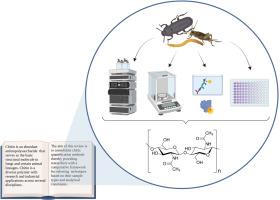A comparative review of chitin occurrence and quantification methodologies with applications to insect sourced materials
IF 12.5
1区 化学
Q1 CHEMISTRY, APPLIED
引用次数: 0
Abstract
Chitin is an abundant aminopolysaccharide that serves as the basic structural molecule in certain animal lineages and fungi. Chitin is a diverse polymer with research and industrial applications across several disciplines. The primary source of chitin is the exoskeleton of arthropods, which include insects and crustaceans. However, chitin does not occur as a pure polymer, but rather as a complex matrix that integrates proteins, pigments, and minerals. Methods for analyzing chitin thereby must deal with the chemical complexity of these biological matrices. Accordingly, several analytical methods have been developed for chitin detection and quantification. Here we provide a detailed summary of methods for the quantification of chitin, with a focus on insect-based materials. These methods fall into several broad categories: proximate analysis, spectroscopic, electrophoretic and chromatographic separation paired with detection, chemical, and immunochemical. Also included is a discussion on methods for chitin purification, hydrolysis, and deacetylation. The aim of this review is to consolidate chitin quantification methodologies across diverse scientific disciplines, providing researchers with a comparative framework for selecting appropriate techniques based on their sample types, research objectives, and analytical constraints. By highlighting the strengths and limitations of each method, this review also seeks to guide future method development.

几丁质含量及定量方法在昆虫源材料中的应用比较综述
几丁质是一种丰富的氨基多糖,是某些动物谱系和真菌的基本结构分子。几丁质是一种多种多样的聚合物,研究和工业应用跨越多个学科。几丁质的主要来源是节肢动物的外骨骼,包括昆虫和甲壳类动物。然而,几丁质并不是一种纯聚合物,而是一种结合了蛋白质、色素和矿物质的复杂基质。因此,分析甲壳素的方法必须处理这些生物基质的化学复杂性。因此,几种分析方法被开发出来用于甲壳素的检测和定量。本文对甲壳素的定量方法进行了综述,重点介绍了昆虫基材料。这些方法分为几大类:近似分析、光谱、电泳和色谱分离与检测、化学和免疫化学配对。本文还讨论了甲壳素纯化、水解和去乙酰化的方法。本综述的目的是整合不同科学学科的几丁质定量方法,为研究人员根据其样本类型、研究目标和分析限制选择合适的技术提供一个比较框架。通过强调每种方法的优点和局限性,本综述还试图指导未来的方法开发。
本文章由计算机程序翻译,如有差异,请以英文原文为准。
求助全文
约1分钟内获得全文
求助全文
来源期刊

Carbohydrate Polymers
化学-高分子科学
CiteScore
22.40
自引率
8.00%
发文量
1286
审稿时长
47 days
期刊介绍:
Carbohydrate Polymers stands as a prominent journal in the glycoscience field, dedicated to exploring and harnessing the potential of polysaccharides with applications spanning bioenergy, bioplastics, biomaterials, biorefining, chemistry, drug delivery, food, health, nanotechnology, packaging, paper, pharmaceuticals, medicine, oil recovery, textiles, tissue engineering, wood, and various aspects of glycoscience.
The journal emphasizes the central role of well-characterized carbohydrate polymers, highlighting their significance as the primary focus rather than a peripheral topic. Each paper must prominently feature at least one named carbohydrate polymer, evident in both citation and title, with a commitment to innovative research that advances scientific knowledge.
 求助内容:
求助内容: 应助结果提醒方式:
应助结果提醒方式:


